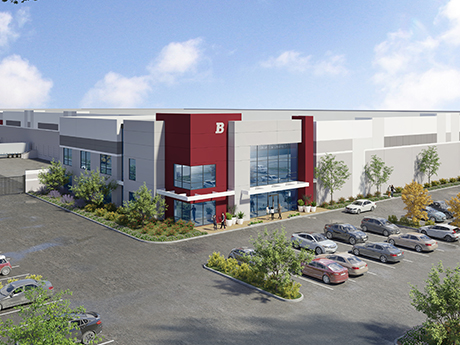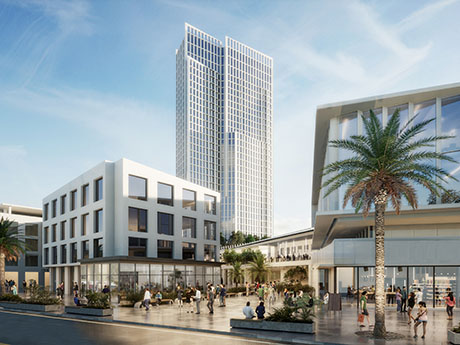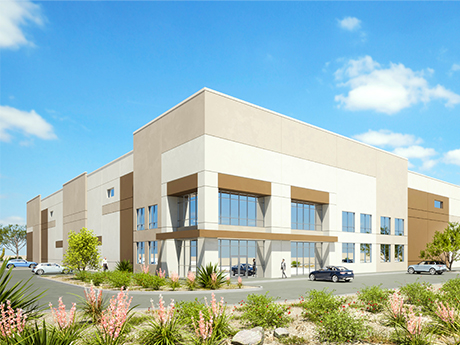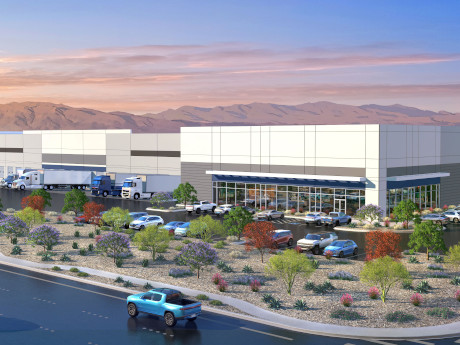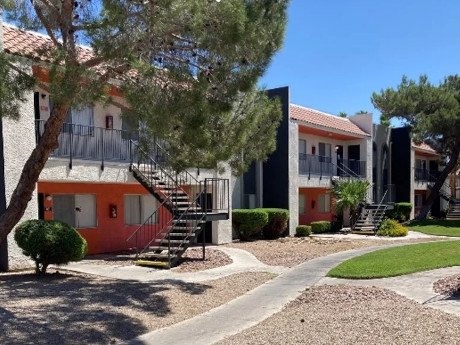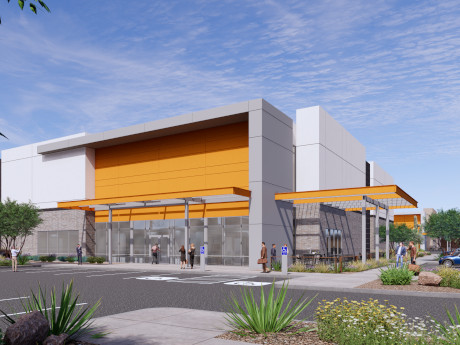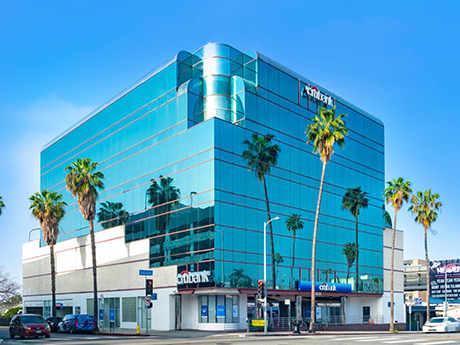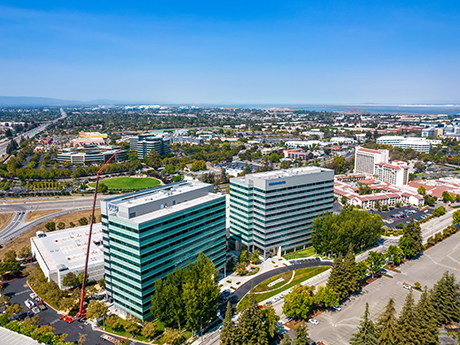Badiee Development has logistics and industrial projects throughout the Western U.S., but its current focus is the region’s three S’s: San Diego, Sacramento, Calif., and Salt Lake City. “Badiee Development is prioritizing leasing at our existing projects in San Diego and Sacramento, and entitling future projects in San Diego, Sacramento and Salt Lake City,” says Ben Badiee, the firm’s founder and CEO. “Our company holds a ‘land bank’ with plans to develop more than 2 million square feet across four distinct projects in three markets.” San Diego Badiee’s headquarters is ripe with industrial ventures for the firm. These include the two-building, 242,969-square-foot Sanyo Logistics Center and the 38-acre Britannia Airway Logistics Center, both of which are being built near the Mexican border in Otay Mesa. Britannia Airway has also been entitled for an interim use of industrial outdoor storage (IOS), allowing the project to accommodate about 1,000 trucks and trailers. “Being in our ‘backyard,’ Otay Mesa has proven to be a highly successful market for the firm,” Badiee says. “It is at the forefront of the onshoring/nearshoring trend for the U.S. and Mexico, and land availabilities are scarce.” Sacramento Land scarcity has also been a driver for Badiee in Sacramento …
Western Market Reports
— By Megan Husic — For a long time, Las Vegas could not seem to attract major sports venues due to fear of sports gambling. But perceptions changed and opportunity skyrocketed when the supreme court struck down the federal law that prohibited sports gambling outside of Nevada in 2018, allowing other states to open sports books. Perception about major sports in Las Vegas seemed to change almost overnight. Since 2017, Las Vegas has attracted successful NHL and WNBA franchises, lured the Raiders from Oakland, Calif., and hosted high-profile events like the NFL draft, Super Bowl, the NCAA men’s Final Four and a Formula 1 Grand Prix. Now, Major League Baseball is on deck as Vegas is currently making plans to develop a $1.5 billion stadium at a site that included the former Tropicana hotel, which is due to be demolished later this year in anticipation of the stadium. Identifying Property with Potential Many sites along the Las Vegas Strip have been developed since the early 1960s. In some instances, these sites have been redeveloped several times over. In the environmental world, redevelopment sites typically occur on brownfields, defined by the U.S. Environmental Protection Agency (EPA) as a property, expansion, redevelopment or …
John Ramous, Nevada region partner at Dermody Properties, discusses how the southern part of the state’s various regions have evolved into industrial hubs — and what the firm is doing to capitalize on this. WREB: What is it about Las Vegas and its fundamentals that have made it an ideal place for industrial? Ramous: There are several key fundamentals driving Las Vegas’ — or Southern Nevada’s — growth as a comprehensive industrial and regional logistics hub. It’s strategically located near Southern California and other major West Coast markets, maintains a business and tax-friendly environment, has a supportive infrastructure, a streamlined permitting process, a focus on sustainability and a large, talented workforce with competitive labor costs. All these factors make this region an ideal place for industrial and logistics, as well as a very attractive location to work, live and conduct business. WREB: Can you tell me more about your Apex project? Ramous: Apex Industrial Park is becoming a primary center for larger and scalable logistics facilities, advanced manufacturing, technology and other distribution uses. Located in North Las Vegas off Interstate 15, it is luring major companies to the region, benefiting the entire Southern Nevada market. Trucks are arriving full …
— By Greg Tassi, vice chair, and Jason Griffis, senior director, Cushman & Wakefield — Southern Nevada continues to distinguish itself through economic diversity. Sports and entertainment, along with a robust industrial real estate market, play a key role in keeping Las Vegas relevant. Formula 1 Racing, the MSG Sphere, MLB’s Athletics and recent discussions around a potential NBA expansion team add to the local excitement. Meanwhile, a compelling industrial real estate market continues to attract and retain globally recognized businesses. The industrial segment in the Las Vegas Valley remains a safe bet for national developers and institutional capital partners, many of which have a healthy appetite to either enter the market or expand their holdings. Land scarcity is the primary barrier to entry for new groups entering the market. Infill sites have become increasingly scarce with very few parcels of more than five acres suitable for industrial development. The bulk of the new inventory will continue to push to the periphery of the Valley, including Sloan and Jean to the south, El Dorado Valley to the southeast and Apex to the north — home to Prologis’ recent 879-acre purchase. Henderson’s recently annexed El Dorado Valley attracted attention with a …
— By Jason Dittenber, Senior Vice President, ABI Multifamily — Las Vegas has attracted residents and real estate investors from around the world with its legendary nightlife, favorable climate and affordable living. In the post-COVID era, the multifamily market in Las Vegas has undergone significant changes. The city has seen a resurgence in an economy heavily reliant on tourism, but challenges persist. They include the current lending environment, increasing operational and construction costs, increased vacancy rates and declining rental rates. These factors have influenced developers and investors in the multifamily sector, creating opportunities and obstacles. Developers like Matter, Southern Land Co. and Grand Canyon Development Partners are helping to change the city’s multifamily dynamic by contributing to its economic and social advancements. Their innovation spans job creation, community development and sustainability initiatives. Moreover, their mixed-use properties foster business expansion, enhancing the city’s commercial landscape and key employment drivers. The Las Vegas MSA witnessed the delivery of 3,318 units in 2023, surpassing the five-year average of 3,069 units. The large number of new multifamily completions has created a more tenant-friendly market. Rental rates have softened but remain relatively high compared to average incomes. Over the past five years, rental rates surged …
Todd Ostransky, vice president of development at Indicap, knew Metro Phoenix was a market the firm wanted to enter for industrial development. Though the area is a hotbed of industrial activity, Indicap’s attention immediately set on Mesa, less than 20 miles east of Phoenix, for its inaugural project. “We identified the East Valley as an area of growth, along with the need for space for mid-bay industrial spec product,” he says. Indicap and joint venture partner AECOM-Canyon Partners chose a 65-acre space within the mixed-use, master-planned community of Eastmark. The JV purchased the site for $48 million in April 2022 during a period of “aggressive expansion,” which saw Indicap kick off 10 developments involving more than 13 million square feet of Class A industrial space across key Arizona corridors. The inaugural Phoenix-area project was Eastmark Center of Industry, which completed Phase I construction in April. This phase brought 978,837 rentable square feet of Class A industrial space to Mesa’s Gateway Airport submarket. The space spans five mid-bay and cross-dock buildings. It features concrete slab on grade, tilt-up exterior walls, and a hybrid wood roof system, ensuring durability and flexibility. Power was also a major amenity for a project of this …
— By Geoffrey West, Senior Vice President, Investment Property Sales and Acquisitions, MDL Group/CORFAC International — The Las Vegas retail market remains a tale of two cities with the tourism-driven Resort Corridor and surrounding MSA comprising two very different markets. In the past, the stories of the “cities” were somewhat divergent with robust development, premium rents, and top-tier restaurant, bar, entertainment and retail tenants dominating in the Resort Corridor. In contrast, the primarily suburban MSA experienced decreasing rental growth rates, metered new development and fewer exciting new tenants. However, looking at the past and current years, as well as into 2025, it appears the party isn’t just on the Las Vegas Strip anymore. Due in part to a statistical undersupply, the suburban Las Vegas retail market is poised to experience increasing rental growth rates over the next 12 to 18 months. The lack of new supply is expected to put continued upward pressure on retail leasing rates and downward pressure on vacancy rates, which are expected to be nearing record 2007 levels. Economic Summary The Las Vegas market saw the completion of more than $8 billion in development in 2023. Among these are the $3.9 billion, 3,644-room Fontainebleau Las Vegas, …
— By Anthony Pappageorge, Managing Director, NorthMarq — The Bay Area multifamily market is showing signs of stabilizing, although there are some persistent challenges present in the market that will impact operations. With 2024 likely to be a period of slower economic growth, there will be a continued emphasis on multifamily property operations. The challenges in the Bay Area rental market have shifted somewhat in recent years. In the period immediately following the pandemic, owners of rental properties were focused on maintaining occupancy levels and rent collections. In the current environment, added pressures surrounding rising property insurance costs and the prospect for additional rent control measures are increasing uncertainty to the Bay Area multifamily market. Occupancy: A Bit Lower than Usual, but Bouncing Back One multifamily property metric where the Bay Area routinely outperforms nearly every other part of the country is occupancy levels. Conditions remain tight at the beginning of 2024, with average occupancies ranging from about 96 percent in the South Bay and San Francisco, to about 94.5 percent in the East Bay. Current occupancies are about 50 basis points lower, on average, than in 2019. This is welcome news to operators who saw rates decline to about 90 …
— By Taylor Stokes, Market Intelligence Analyst, Avison Young — The Los Angeles office market continues to struggle with a 24.7 percent vacancy rate at the end of the first quarter of 2024, according to Avison Young’s first-quarter Los Angeles office market report. Leasing activity picked up slightly in the first quarter of 2024 with 951 leases recorded. This equated to 3.5 million square feet, up 5.4 percent from the fourth quarter of 2023 when there were 902 leases signed. To put the decline of occupancy in perspective, the first quarter of 2022 ended with a 15.4 percent office vacancy rate, which was up from 15 percent at the end of 2021. It was also up from the previous high of 13.1 percent that was recorded in 2010. There were a couple lease transactions to highlight in the first quarter of 2024. Snap picked up 400,000 square feet in Santa Monica, while Bank of Tokyo Mitsubishi signed a nearly 62,000-square-foot lease in Downtown Los Angeles. Downtown continues to struggle with the highest vacancy in the market at 28.6 percent. The anticipated return to office hasn’t happened, as many users see the hybrid work schedule continuing for the long-term. They, therefore, …
— By Kirsten Grado, Toss Vallentine and Wing Lee of JLL — The resilience of the South Bay/Silicon Valley economy has been tested with the dramatic change in hybrid work formats that enabled employees to work from anywhere. While office vacancy has hit near record levels over the past year, signs of strengthening fundamentals are pointing to a bottoming of the market and a period of opportunity for companies and investors with long-term views. So, what is marking the signs of optimism? Leasing activity has continued to improve as companies in technology, professional services, financial services/consulting and other sectors leased 865,000 square feet across 61 transactions in the first quarter of 2024. The largest leases were PwC agreeing to move from downtown San Jose into 141,000 square feet within the top three floors of One Santana West, as well as a confidential tech firm leasing 162,000 square feet at Coleman Highline, also in San Jose. Other notable leases were TDK InvenSense renewing its 82,000-square-foot space in San Jose, as well as KMPG and the 49ers organization each taking about 50,000 square feet of space in new leases in Santa Clara. Premier space remains in high demand as companies look to …


